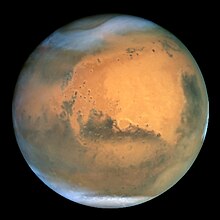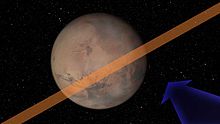2007 WD5

2007 WD5 is a 50 m (160 ft) diameter Near-Earth object and a Mars-crosser asteroid discovered on November 202007 by Andrea Boattini of the Catalina Sky Survey. It has been estimated by NASA's Near Earth Object Program (NEOP) to have a 1-in-75 chance of colliding with Mars.
Discovery
The asteroid was discovered on November 202007 by Andrea Boattini[1] of the NASA-funded Catalina Sky Survey on Mount Lemmon, near Tucson, Arizona, USA, using a 1.5m telescope.[2] It was discovered in the constellation Taurus at an apparent magnitude of +20. This is about 400,000 times fainter than most people can see with the naked eye on a dark night far from city lights.[1] It was discovered nineteen days after passing near the Earth. By the time it arrives at Mars it will have an apparent magnitude of roughly +26 and will appear over 100x fainter than at the time of discovery.[3]
Comparison to Tunguska 1908 event
2007 WD5 is roughly the size of the cometary object that caused the Tunguska event in 1908, in remote central Siberia, Russia. Due to the Earth's greater gravity an impact with the power of Tunguska is expected to occur an average of every one hundred years. Since Mars has only 1/10th the mass to attract objects, these types of impacts occur only every one thousand years on Mars.[4]
Position and possible future impact

On November 12007, nineteen days before its discovery, this small asteroid passed within 7.5 million km (5 million miles or 0.0476 AU) of the Earth.[2]
By December 212007, 2007 WD5 was approximately half way between Earth and Mars traveling at 27,900 mph, and was estimated by NASA's Near Earth Object Program (NEOP) to have a 1-in-75 chance of colliding with Mars on January 302008 at approximately 10:55 UT.[2] It should pass within 25,000 km (0.00014AU) of Mars.[5] If the asteroid were to collide with Mars, it would hit with a velocity of about 13.5 km/s (8.4 miles per second), and would produce an explosion equivalent to about 3 megatons of TNT.[2] Due to the thin atmosphere of Mars, it is predicted that the asteroid would reach the surface intact and blast out a crater approximately 0.8 km (0.5 mi) in diameter.[6] A crater this size would be equal to the size of the famed Meteor Crater in Arizona, USA. NASA officials say if it does hit Mars, it will do so north of the location of the Opportunity rover.[1]
In July of 2003, the asteroid passed within 0.008AU of Mars.[5] If 2007 WD5 passes Mars safely, its low inclination to the Ecliptic of only 2.3 degrees and high eccentricity of 0.6 could cause it to swing past Mars and/or Earth years or decades in the future.
References
- ^ a b c Lori Stiles, University Communications (December 212007). "Catalina Sky Survey Discovers Space Rock That Could Hit Mars". The University of Arizona. Retrieved 2007-12-23.
{{cite web}}: Check date values in:|date=(help) - ^ a b c d Steve Chesley and Paul Chodas (December 212007). "Recently Discovered Asteroid Could Hit Mars in January". NASA/JPL Near-Earth Object Program Office. Retrieved 2007-12-21.
{{cite web}}: Check date values in:|date=(help) - ^ Horizons Brightness Difference between 11-20-07 and 01-30-08: (5th root of 100) ^ (@marsJan30th APmag 25.9 - DiscoveryNov20th APmag 20.2) = 190x
- ^ "Astronomers Monitor Asteroid to Pass Near Mars". NASA/JPL. 2007-12-21. Retrieved 2007-12-22.
- ^ a b "Horizons Output Mars/Earth 2003/2008". Retrieved 2007-12-21.
- ^ Johnson Jr., John (2007-12-21). "Asteroid on track for possible Mars hit". Science. Los Angeles Times. Retrieved 2007-12-21.
{{cite news}}: Check date values in:|date=(help)
External links
- Orbital simulation from JPL (Java) / Horizons Ephemeris
- Near Earth Object Program (at NASA.gov)
- A Meteoroid Hits the Moon (25cm wide) on May 2, 2006
